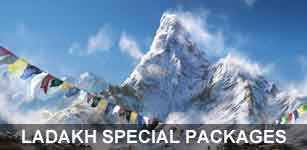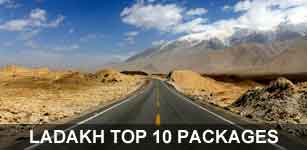
When is the right time to travel to ladakh ?
Unlike many destinations in India, Ladakh is not an all-year-around destination. Ladakh is a beautiful place that is located in the Himalayan range. It is located on the Indus River bank. This place has amazing scenery and many adventure routes for motorcycle enthusiasts. In short, the best time to visit Leh Ladakh is summer between the end of March to middle of August. The prime tourist time is between June and August.
Manali to Leh route open around Mid May to end of May and depends on weather conditions due to heavy snow at Rohtanag pass / Bara La cha and Tanglan La Pass. For safter side you may schedule your programme at fourth week of May onwards from this sector. Route will remain open till end of September/ October - Please check the weather report before your travel.
Srinagar to Leh route open normally by the end of April and again subject to weather conitions. Better to travel May first week or Second week onwards. Route will remain open till end of October and sometime till November.
Flights are open round the year though flight schedule may get change in winter season from October to March.
In Tourism aspect if you are planning for Ladakh, May to September will be preferred month of travel. However tourst season starts from first week of April till October. In the month of April and October nights will be cold enouogh. However days will be warm and sunny and no problem to visit around the places.
Ladakh during the Summer time (March- June)
While you ponder over and continuously think about the, you would be happy to read through this piece of information that endures enlightening to the fullest regarding the popular times to visit Ladakh along with the Best Season to Visit Ladakh.
Temperature: 20-30 Degrees
Weather: The weather remains warm and comfortable and sun shines brightly.
Why to visit now: Out of all the seasons, summer calls to be one of the best seasons when you can witness and enjoy the energizing surrounding of the place to the fullest. At this season the snow seems to have softened rendering spectacular buzz of sceneries.The late April showcases excellent changes. The Pangong Tso lake and the Tso Moriri lake begin to melt fast at this time considerably disclosing the spectacular hue and sight of the place. At this time Leh out cases beautiful weather condition endowing clear sky.At this time, you must consider visiting places like Stongdey Monastery, Likir Monastery, Shey Monastery and Thiksey Monastery.
Significance: At this time you can also relish best festivals like YuruKabgyat, Hemis Festivals, SakaDawa which is only held during the month of June. The Hemis festival which is celebrated in honour of the founder of Tibetan Buddhism, Guru Padmasambhava is one to witness. It showcases the amazing masked performances, brightly hued costumes and unique music which simply cannot be missed.
Know before you visit: Between April to mid of May there is no heavy snowfall and the summer season slowly and steadily takes over the place completely. The travellers who aim to visit Ladakh during this time can search for homestays, hotels, places, and guesthouses on many online sites. If you plan on visiting during this span of time then you must definitely opt for flight booking as all the passes and the roads to the place is generally blocked or are not open. However, though it is summer time the weather at this time is not warm or sunny.
The beginning of the seven to ten days in the month of June isn’t meant for traveling purpose to Ladakh as most of the roads at this time is blocked. At this time, if you wish to travel to Ladakh, you must definitely choose flight as this is the best option if you wish to travel. The major airport in the area to visit this area during the summer season is the KushokBakulaRimpochee Airport. Also, in the mid of this time, the travellers must surely visit the highway in between Srinagar and Leh. This is the highway that remains open at this time of the year.
If you wish to visit Ladakh by road during this time then you must consider going from the Valley of Kashmir via Kargil, which is about a distance of four hundred and thirty-four kilometres. This is the route that remains open from the early month of June to the month of November. Finally, the longest road route that is about a distance of four hundred and seventy-three kilometres, the Manali-Leh road route is open in the middle of June and remains open until early October.
Tips: Wear sunscreen and protect yourself from direct sunshine as the thin atmosphere here can cause the sunrays to get quite intense. Beginning of the season still calls for you to pack in some warm clothes as the nights can get bit too cold.
Ladakh during the Monsoon time (July-August)
Temperature: 10-20 Degrees
Weather: Monsoons in Ladakh are as harsh and untoward as winters if not more. The air is crisp, blue and usually clear. Beginning in July, monsoons in Ladakh do not last long, and whatever little rainfall that the area receives is generally in the form of heavy but short-lived downpours.
Why you should visit now: The weather is refreshing and perfect for outings. It is also a great time for adventure activities such as white water rafting which can be indulged in at Indus and Zanskar rivers. The period from May to October is also a wonderful time for going on the many treks organized in the area, especially the Kang Yatse trek, Markha Valley trek and the one from Spituk to Stok.
Significance: Monsoon is the time of many mesmerizing festivals such as Karsha Gustor that is held at Karsha, Zanskar Valley’s biggest monastery; the PheyangTsedup, which is the annual festival, organized at the Pheyang monastery; KorzokGustor, which is held at Korzok monastery, located near Moriri Lake.
Know before you visit: The place is infamous for occasional incidents of landslides and cloudbursts during this period. This time of the year, roads, especially the Manali-Leh highway can become hard to traverse owing to washing off of the narrow road or landslides due to rains.
Tips: If travelling to Ladakh in Monsoons, it is necessary that you pack such clothes that are light weight and easy to dry and wear shoes that are waterproof. Make sure you also carry a raincoat and/or an umbrella and sunscreen with you. Check the weather report before embarking on your journey to stay safe.
Ladakh during the winter (September-February)
Temperature: Below 0 Degree (minimum most recorded temperature here is -23 Degrees)
Weather: During the winters the temperature steadily drops from September (5 Degrees to -21 Degrees ) to January (-2 Degrees to -14 Degrees ) and then gradually rises again. The weather is pleasantly chilly at the early phase (September-October) of the season, with cold winds blowing in the evenings. The latter phase of winters (November-February) can be extremely unbearable with temperatures dipping violently, making it impossible to enjoy your stay. Temperature in Kargil during this part of the season can drop up to -50 Degrees
Why to visit now: Winter calls to be the time when you can relish the beauty and adventure of trekking through one of the best treks in the world known as the Chadar Trek. Moreover, you are also sure to relish trekking over the solidified and grand Zanskar River, which is highly loved and cherished by the travellers. Only the early phase of the winters are good for travelling to the place. This period is ideal for many great and popular treks in Ladakh including the famous Frozen River Trek or the Zanskar Valley trek. The period from mid of January to March is however best suited for Chadar trek.
Significance: Many remarkable festivals fall during the wintertime in Ladakh. These prominently include SpitukGustor, Stok Monastery Festival, Dosmoche, ThiksayGustor, Matho Monastery festival and Ladakhi Losar. While the ones falling in summers are shadowed by tourist crowds and photographers, attending these winter fests are sure to give you a glimpse into the lives and culture of the locals like none other.
Know Before you visit: Ladakh sees very sparse crowd of tourists from November to February due to heavy snowfall in the area. This is also the reason why many trekking routes too are closed down at times. Also, be prepared for frequent power cut in this season.
Tips: The extremely low temperature and high altitude can cause AMS or common cough and cold. Hence, it is good to be prepared with necessary precautions such as multiple layers of warm clothing, necessary medicines and taking enough fluids. You can take oxygen at oxygen bars if experiencing dizziness and headaches, which is common due to the high altitude. Carry a 1000mAh power bank and several spare batteries as the cold tends to drain out batteries quickly.

